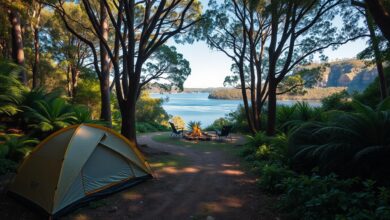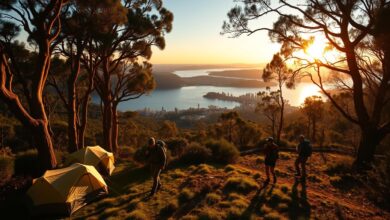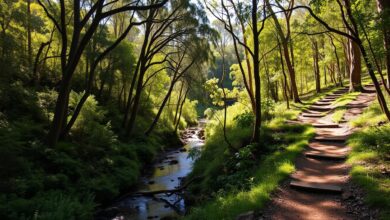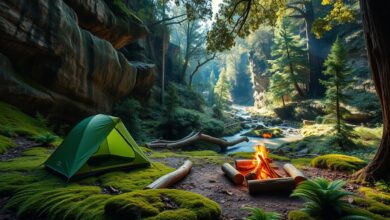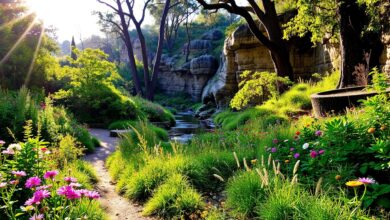Discover the natural beauty of Dharug National Park, where wilderness adventures await. Located near Sydney, this park offers a unique escape from the city’s hustle and bustle.
The park’s diverse landscapes, including rugged mountains and serene valleys, provide an ideal setting for camping and trekking. Visitors can explore various trails, enjoy scenic views, and experience the region’s rich flora and fauna.
Key Takeaways
- Explore Dharug National Park’s diverse landscapes through camping and trekking.
- Enjoy scenic views and experience the region’s rich wildlife.
- Follow camping tips for a safe and enjoyable wilderness adventure.
- Discover the park’s unique flora and fauna.
- Escape the city and connect with nature.
Overview of Dharug National Park’s Natural Beauty and History
Dharug National Park is a gem in Australia’s countryside. It boasts stunning landscapes and a rich history. From mountains to valleys, the park is a haven for plants and animals.
Key Features of the Park
The park is known for its diverse ecosystems. You’ll find eucalyptus forests, heathlands, and woodlands. These places are home to kangaroos, wallabies, and over 100 bird species.
The park’s rugged cliffs and lookouts offer amazing views. They’re perfect for nature exploration and outdoor activities.
The park’s highlights include:
- Scenic walking trails for all levels
- Views from lookouts like Wiseman’s Ferry and Cogo
- Diverse flora, including eucalyptus and wildflowers
- Chances to see native wildlife like kangaroos and wallabies
Historical Significance
Dharug National Park is a treasure for nature lovers and history buffs. It’s filled with Aboriginal heritage, like rock engravings and cave paintings. These sites show the lives of the indigenous people who lived here.
The park also marks early European settlement. You can see old farms and historical buildings. Exploring these sites helps you understand the area’s historical significance and cultural heritage.
Planning Your Visit to Dharug National Park
Before you visit Dharug National Park, knowing how to plan is important. You’ll want to know about camping tips and gear recommendations. Being ready will help you enjoy everything the park offers.
Best Time to Visit
The best times to visit are spring (September to November) and autumn (March to May). The weather is perfect for camping and trekking. For more details on campsites, check out Mill Creek Campground.
Entrance Fees and Permits
Visitors must pay an entrance fee to enter Dharug National Park. The cost depends on your vehicle and how long you stay. You’ll also need permits for camping and other activities. For the latest info, visit the park’s website or call the park office.
| Vehicle Type | Entrance Fee (Daily) | Entrance Fee (Annual) |
|---|---|---|
| Motorcycle | $6 | $30 |
| 2WD Vehicle | $12 | $65 |
| 4WD Vehicle | $17 | $95 |
Essential Packing List
It’s important to pack the right gear for a great trip. You’ll need comfy hiking shoes, clothes for the weather, a first-aid kit, and enough food and water. For gear recommendations, choose items that are tough and made for the outdoors.
- Comfortable hiking shoes
- Weather-appropriate clothing
- First-aid kit
- Sufficient food and water
- Map and compass or GPS device
Plan ahead and pack what you need for a safe and fun trip to Dharug National Park. Remember to check the weather forecast and book your campsite reservations early.
Camping Options in Dharug National Park
Dharug National Park offers several camping spots in its beautiful landscapes. Camping here lets visitors enjoy the Australian wilderness. It’s a chance to connect with nature.
Campgrounds Available
Dharug National Park has many campgrounds for different needs. You can choose from basic sites for a rougher experience or more equipped ones for comfort. There’s something for everyone.
- Basic Campgrounds: Perfect for those who love the wild, these sites offer a true wilderness adventure.
- Equipped Campgrounds: For a more comfortable stay, these have picnic tables, barbecues, and clean water access.
Facilities and Amenities
The campgrounds in Dharug National Park have many facilities. These include:
- Picnic areas and barbecue facilities
- Access to potable water
- Toilet facilities, with some having flush toilets
Remember, some facilities might be limited or closed seasonally. Always check before you go.
Booking Your Campsite
Booking your campsite early is a good idea. You can book through the National Parks website or by calling their office.
When booking, tell them how many people are in your group, your dates, and any special requests. It’s also a chance to ask about camping safety guidelines or rules.
Planning and choosing the right campsite makes your camping trip at Dharug National Park unforgettable.
Trekking Trails in Dharug National Park
The trekking trails in Dharug National Park are a must-see. They offer stunning views and a deep dive into the Australian wilderness. There’s a trail for every skill level and interest, so you can pick the one that suits you best.
Popular Trekking Routes
Dharug National Park has many famous trekking routes. These trails range from easy walks to tough hikes. There’s something for everyone.
- The Great North Walk is a standout trail. It’s over 250 kilometers long and offers amazing views.
- The Dharug Trail is also a hit. It has beautiful lookouts and historic sites.
Trail Difficulty Levels
It’s important to know the difficulty level of each trail. Dharug National Park’s trails are rated based on their terrain, length, and how hard they are to walk.
| Trail Name | Difficulty Level | Distance |
|---|---|---|
| Great North Walk | Moderate to Hard | 250 km |
| Dharug Trail | Easy to Moderate | 15 km |
Safety Tips for Trekkers
When you’re trekking, safety comes first. Here are some key tips for a safe and fun trip:
- Always check the weather forecast before you go.
- Bring enough water and snacks to keep you going.
- Wear the right clothes and shoes for the terrain and weather.
- Tell someone your trekking plans, including where you’re going and when you’ll be back.
By following these tips and staying alert, you can have a great time trekking in Dharug National Park.
Wildlife and Flora at Dharug National Park
Dharug National Park is a treasure trove of flora and fauna. It offers a unique experience for all who visit. The park is a sanctuary for wildlife and plants, attracting nature lovers and those curious about Australia’s natural world.
Common Animal Sightings
The park is alive with wildlife. You can see kangaroos, wallabies, and many bird species. Echidnas, possums, and other native animals also call the park home.
- Kangaroos and wallabies are commonly seen grazing in the park’s open areas.
- A variety of bird species, including parrots and cockatoos, can be spotted.
- Echidnas and possums are among the other native animals that inhabit the park.
Notable Plant Species
The park’s plants are as fascinating as its animals. It boasts a variety of native plants and trees typical of the Australian bush. You’ll find eucalyptus trees, banksias, and waratahs among others.
Key Plant Species:
- Eucalyptus trees, which are iconic in Australian landscapes.
- Banksias, known for their distinctive flower spikes.
- Waratahs, a flowering plant that is the floral emblem of New South Wales.
Conservation Efforts
Dharug National Park is dedicated to protecting its biodiversity. It focuses on habitat restoration, controlling invasive species, and educating visitors. This ensures the natural environment is preserved for future generations.
Conservation initiatives in the park are vital. They help maintain the ecosystem’s balance. This way, the park’s beauty can be enjoyed by all for years to come.
Activities Beyond Hiking and Camping
Dharug National Park is a paradise for outdoor lovers, with more than just hiking and camping. Its varied landscapes and ecosystems are perfect for different nature exploration activities.
Birdwatching Opportunities
The park is a birdwatcher’s dream, with many species to see. You can spot kookaburras, cockatoos, and parrots. Its woodlands and wetlands are home to a rich variety of birds.
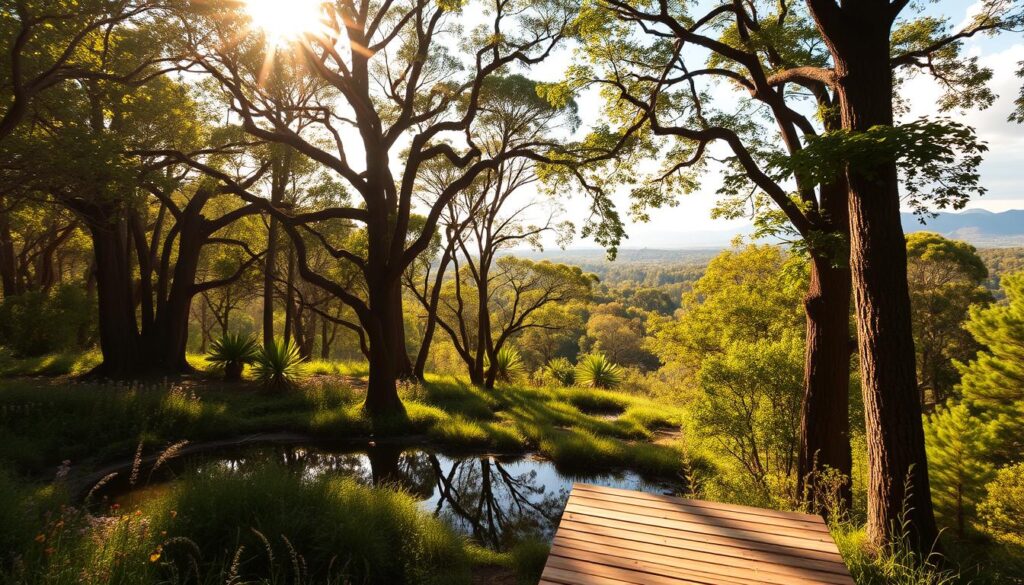
Photography Spots
Dharug National Park is a photographer’s paradise. Its stunning landscapes and wildlife offer endless photo opportunities. Lookouts, waterfalls, and unique rock formations are just waiting to be captured.
Looking to explore more? Check out camping spots in Sydney for other great places to visit.
Fishing Regulations
If you love fishing, Dharug National Park has rules to protect its waters. You need a recreational fishing license and must follow bag limits and size restrictions. The park’s rivers and streams are home to bass and trout.
- Obtain a recreational fishing license before fishing.
- Adhere to bag limits and size restrictions.
- Check for any closed or restricted fishing areas.
Essential Tips for a Safe and Enjoyable Experience
For a safe and fun trip to Dharug National Park, it’s important to know and follow key safety rules. Visitors need to be aware of dangers and take steps to avoid them.
Fire Safety Guidelines
Fire safety is very important when camping in Dharug National Park. Campfires can be dangerous if not handled right. To stay safe, visitors should:
- Use only designated fire pits and follow park rules for firewood.
- Have a bucket of water or a fire extinguisher ready.
- Check the wind and put out fires when it’s windy.
- Make sure to fully extinguish campfires before leaving them.
Fire safety is everyone’s job in the park. By following these tips, visitors can help prevent wildfires and keep everyone safe.
Weather Preparedness
The weather in Dharug National Park can change quickly. It’s important to be ready for different weather conditions to have a safe and fun visit.
| Weather Condition | Precautions |
|---|---|
| Rain | Bring waterproof gear, stay updated on weather forecasts. |
| High Temperatures | Drink plenty of water, wear protective clothes, avoid hard activities when it’s very hot. |
| Strong Winds | Make sure camping gear is secure, be careful with campfires. |
Being informed and prepared can make your visit safer and more enjoyable.
Leave No Trace Principles
The Leave No Trace principles help reduce the impact of outdoor activities on the environment. By following these principles, visitors can help keep Dharug National Park beautiful.
- Plan ahead and prepare.
- Travel and camp on durable surfaces.
- Dispose of waste properly.
- Leave what you find.
- Minimize campfire impacts.
- Respect wildlife.
- Be considerate of other visitors.
By adopting these practices, visitors can help protect the park for the future.
By following these tips, visitors to Dharug National Park can have a safe and fun time while also protecting the environment. Whether you’re camping, hiking, or just enjoying the views, being prepared and aware is key to a great visit.
Nearby Attractions to Explore
Beyond Dharug National Park, a world of attractions awaits. The area is filled with natural wonders, cultural sites, and fun activities. These can make your visit even better.
Other Parks and Nature Reserves
For nature lovers, there are many parks and reserves near Dharug National Park. Some of these include:
- Goulburn River National Park: Known for its rugged landscapes and diverse wildlife.
- Yengo National Park: Famous for its Aboriginal rock art and scenic views.
- Wollemi National Park: Home to the rare Wollemi Pine, a species thought to be extinct until its rediscovery in 1994.
| Park Name | Key Features | Activities |
|---|---|---|
| Goulburn River National Park | Rugged landscapes, diverse wildlife | Hiking, camping, wildlife watching |
| Yengo National Park | Aboriginal rock art, scenic views | Hiking, rock art viewing, photography |
| Wollemi National Park | Wollemi Pine, wilderness areas | Hiking, camping, nature study |
Local Towns and Culture
The area around Dharug National Park has charming towns. These towns give a peek into local culture and history. Visitors can check out:
- Wisemans Ferry: A historic ferry crossing with picturesque views.
- Lower Portland: Known for its scenic river views and historic sites.
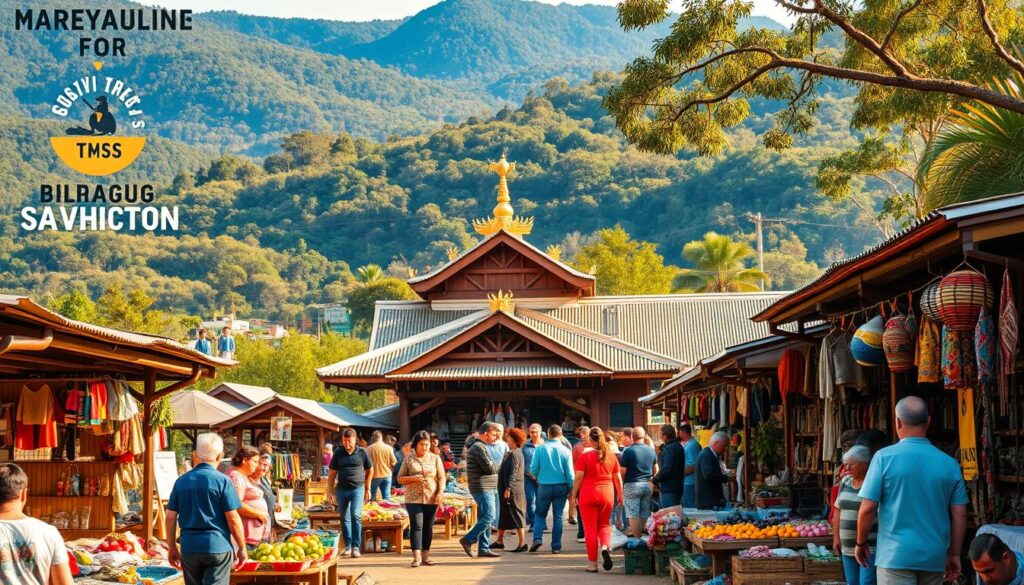
Culinary Experiences
After exploring, visitors can enjoy local food. It’s a mix of traditional Australian dishes and modern twists. Highlights include:
- Farm-to-table restaurants with fresh, local produce.
- Cafes with artisanal coffee and tasty pastries.
- Local markets where you can try regional specialties.
Visiting nearby attractions adds to your travel experience. It also helps you understand the area’s natural beauty and culture.
Resources for Further Exploration
To make your camping and trekking at Dharug National Park better, there are many resources to help. The official park website is a great place to start. It has the latest on park rules, camping spots, and trails. It’s a key part of our Ultimate Guide to Camping & Trekking at Dharug National Park.
Official Resources
The Dharug National Park website gives you all you need to plan your trip. It has tips on gear and camping essentials.
Navigation Tools
Mobile apps can really help you explore the park’s big areas. They have maps and updates in real-time.
Recommended Reading
If you want to learn more about Dharug National Park, there are books and guides. They help you understand the park’s history, plants, and animals. This knowledge makes your adventure even more special.
FAQ
What is the best time to visit Dharug National Park for camping and trekking?
Spring (September to November) and autumn (March to May) are the best times. The weather is mild, perfect for outdoor fun.
Are there any specific camping gear recommendations for Dharug National Park?
Bring a strong tent, warm sleeping bag, and a camping stove. Don’t forget comfy hiking boots and layers for changing weather. Also, a portable water filter or purification tablets are essential for safe drinking water.
How do I book a campsite in Dharug National Park?
Book campsites online through the National Parks and Wildlife Service website or by calling their customer service. Booking early is wise, as it gets busy.
What are the safety guidelines for trekking in Dharug National Park?
Always check the weather first. Wear the right clothes and shoes. Bring lots of water and snacks. Tell someone where you’re going and when you’ll be back. Stick to the trails to avoid getting lost.
Can I bring my dog on the trekking trails in Dharug National Park?
Dogs aren’t allowed on most trails to protect wildlife. Check the park’s website for pet rules.
Are there any facilities available for campers within Dharug National Park?
Campgrounds have basic facilities like picnic tables, toilets, and barbecues. Some have potable water. Check with park rangers or the website for details.
What wildlife can I expect to see in Dharug National Park?
You might see kangaroos, wallabies, and many birds. Keep a safe distance to respect their space.
Are there any guided tours available for camping and trekking in Dharug National Park?
There are no official tours by the park. But, some companies offer guided experiences. Look for reputable ones and book early.
What are the Leave No Trace principles, and why are they important in Dharug National Park?
Leave No Trace principles help protect the environment. They include proper waste disposal, not feeding wildlife, and staying on trails. These actions keep Dharug National Park beautiful and intact.

